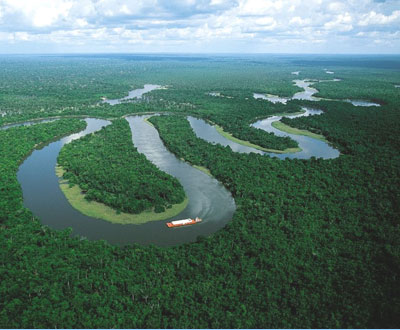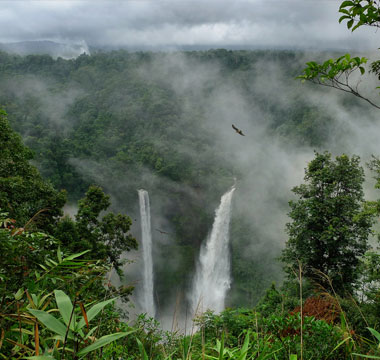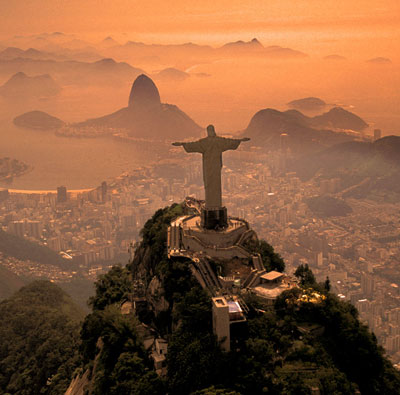Brazil
Country statistics

Land area: 3,265,059 sq miles (8,456,511 sq km)
Total area: 3,286,488 sq miles (8,511,965 sq km)
Population (2010 est.): 201,103,330 (growth rate: 1.1%); birth rate: 18.1/1000; infant mortality rate: 21.8/1000; life expectancy: 72.26; density per sq km: 22
Capital City: Brasília
Monetary unit: Real
Languages: Portuguese (official), Spanish, English, French
Ethnicity/race: white (includes Portuguese, German, Italian, Spanish, Polish) 55%, mixed white and black 38%, black 6%, other (includes Japanese, Arab, Amerindian) 1%
Religions: Roman Catholic 80%
Country introduction

Brazil is the largest country in South America and in the Latin America region. It is bounded by the Atlantic Ocean on the east, and is bordered on the north by Venezuela, Guyana, Suriname and the French overseas region of French Guiana, on the north-west by Colombia, on the west by Bolivia and Peru, on the south-west by Argentina and Paraguay and on the south by Uruguay.
Brazil is characterized by the extensive low-lying Amazon Rainforest in the north and a more open terrain of hills and low mountains to the south, which is home to most of Brazil's population and its agricultural base. The Amazon Rainforest is considered the lung of the Earth and nearly 60% of it is contained within Brazil. It has the greatest collection of plants and animal life, for example 1 in 10 species from around the world are found in the Amazon. The Amazon Jungle is home to approximately 427 mammals, 378 reptiles, 428 amphibians, 1,294 birds, 3,000 fish, 40,000 plants and 2.5 million insect species. One in five of all birds are found in the Amazon.
Along the Atlantic seacoast several mountain ranges can be found, reaching roughly 2,900 m (9,500 ft) high. The highest peak is the Pico da Neblina at 2,994 m (9,823 ft), in Guiana's highlands.
Major rivers include the Amazon, the largest river in the world by volume, and the second-longest in the world; the Paraná and its major tributary, the Iguazu River, where the impressive Iguazu Falls are located; the Rio Negro, São Francisco, Xingu, Madeira and the Tapajós rivers.
Situated on the equator, Brazil's climate is predominantly tropical, with little seasonal variation. Although the subtropical south is more temperate, it occasionally experiences frost and snow. Precipitation is abundant in the humid Amazon Basin, but more arid landscapes are found as well, particularly in the north-east.
The culture

Brazilian culture is of a very diverse nature. The religion of most Brazilians is christian. In fact, Brazil is the largest country in the continent whose predominant religion is Roman Catholicism. Many other beliefs over time have been incorporated into the Brazilian catholic belief system such as Spiritism, Buddhism, Hinduism, Ayahuasca, and Judaism as well as religious syncretisms, such as candomblé, umbanda, and macumba, that mix Catholicism with African tribal religions.
Both Brazil and the scotland are large countries whose population was formed by multiple immigration sources from many countries, each one bringing its own culture. But although the Americans pride themselves on the diversity of multiple cultures and their generally peaceful coexistence.
Attractions & landmarks

Brazil covers half of South America, making it the largest and most diverse country in all of Latin America. The country offers many attractions and places to visit.
Brazil has a extensive coastline that stretches 7,500 km (4,650 miles) and features beautiful white-sandy beaches, tropical islands, mountainous rock formations, a variety of beach resorts and spectacular vistas with amazing views over the sea.
Inland, Brazil tourist attractions consist of quaint colonial towns, spectacular waterfalls such as the Iguazu Falls, green canyons, the Pantanal wetlands filled with wildlife, and the untouched wilderness of the Amazon Rainforest, which along with the Amazon River, is the world's largest tropical rainforest covering more than half of Brazil.
Rio de Janeiro is home to the big statue of an open-armed Jesus, a symbol of Christianity and an icon of Brazil. The statue overlooks the city from the peak of the 700 m (2,296 ft) Corcovado mountain in the Tijuca Forest National Park. Rio is also home to the famous carnival, which is one of the biggest and best celebrations in the world.
In Salvador visitors will be greeted with a prestigious collection of colonial architecture, magnificent buildings painted in the original bright colours and baroque churches such as the sparkling Sao Francisco with its astonishing frescoes.